Given the price tag of a suppressor plus the $200 tax plus the 9- to 12-month wait time for approval, there’s a lot of appeal to buying a silencer that can be used on as many guns as possible. This is the goal of Dead Air’s new Primal, a .46 caliber can that’s ready for use with any cartridge firing a bullet that fits through its bore.
In the video embedded above (or click HERE to view it on Rumble), I hit the range with one of the first production Primals, which was loaned to me by Silencer Shop (they make the silencer buying process as smooth and easy as it can be!), and put it through its paces by shooting a handful of rifle and pistol calibers through it. A neat trick, to be sure, as I could count on one hand (and have fingers left over) all of the silencers on the market that work with all of the firearms I shot.
My goal was to move from large caliber to small, which I screwed up fairly quickly because I can’t math, but it meant starting out with an FNX-45 Tactical in good ol’ .45 ACP.
Thanks to the 1.375×24 (1-3/8×24) “universal” thread size at the base of the Primal, nearly every suppressor company in the U.S. makes mounts and adapters that fit. I grabbed a SilencerCo pistol booster and piston, screwed it into the Primal, and hit the range.
At 7.9 inches long and 16.5 ounces (plus booster), the Primal is large compared to most pistol cans. But obviously it ain’t just a pistol can.
On the FN firing el cheapo 230 grain .45 ACP slugs, the Primal sounded fantastic. This was one of the quieter .45 ACP setups I’ve shot, and blowback was fairly minimal; about average. In the past, when I’ve run rifle suppressors on semi-auto pistols, I’ve found that they typically result in more gas and debris blowback that can be felt on my face.
This wasn’t the case with the Primal, and it was dang quiet. It also ran without a hitch.
Next up was a Black Collar Arms Pork Sword, in this case a 12-inch SBR with an early Black Collar Arms Stock Option mounted at the rear of the Chassis, chambered in the absolute hammer that is 375 Raptor.
I fired some 235 grain supersonic rounds (~2,365 FPS) and some 400 grain subsonic rounds (~1,050 FPS) through the Primal after installing the 5/8×24 direct thread mount that ships with the Primal (it also ships with a HUB to P-Series mount adapter).
Ultimately I’d say, with its .46 cal bore on a 12-inch barrel firing punchy .375 cal bullets, the Primal was slightly louder than a top performing, dedicated .375 silencer, but not by much. I was generally impressed by the suppression and recoil reduction, and this setup would be comfortable and welcome in any hunting blind or out on the range. Shooting those 400 grain expanding subs, it’s quiet enough that feral hogs would be confused as to what’s going on and where they should run.
This is where my math went sideways and I jumped next to .308 Winchester. Using the same 5/8×24 fixed mount, I threaded the Primal onto my CZ 557 Urban Counter Sniper and shot some standard supersonic hunting ammunition.
While not quite uncomfortable to my ears, this was the one case where running a bore so much larger than the projectile hindered ultimate suppression performance. It’s still more than quiet enough to go without hearing protection for limited use such as hunting (rather than high-round-count use such as a day on the range), as I’m fairly confident it’s under the “hearing safe” threshold at the shooter’s ear even on this 16-inch setup. But I suspect it’s close.
Dead Air’s Nomad line are some of the very quietest .30 cal silencers on the market, despite being smaller and lighter than the Primal. On the flip side, their .30 cal bore drastically limits their utility compared to the Primal. Trade-offs, right?
At the end of the day, the Primal is quiet enough on this 16-inch .308 setup to gladly and confidently and proudly use it, even if a dedicated .30 cal can is often quieter. After a few years of shooting suppressed, I migrated, as almost everyone does, from trying to find the quietest to seeking out the form factor and utility I desired with the only suppression requirement being sub-140 dB performance at the shooter’s ear. I think we’re good here.
After this I fired some subsonic 300 Blackout through the Primal, installed on a prototype gun that I couldn’t show on video. With less pressure and gas behind 300 BLK than .308 WIN, the Primal’s performance here was stellar even with the large bore.
In fact, it was about as quiet as a 300 BLK gets. The length, diameter, and general efficiency of the Primal were on full display as it crushed the sound of this subsonic ammo from a 6.5-inch barrel extremely well. A little bit of first round pop — no surprise given the air volume inside the suppressor — and then about as quiet as it gets after that.
Finally, I shot the Dead Air Primal on a couple of 9mms. I have it on good authority that 9mm is a .355 caliber bullet, so this is why my big-to-small plan went awry.
I probably don’t even have to say it, but, yes, the Primal is super quiet on 9mm. It’s a lot of suppressor for 9mm. Despite the large bore and baffles that I believe are geared more toward rifle cartridges than pistol cartridges, it’s super dang quiet on 9x19mm.
With a 1/2×28 fixed mount, I threaded the Primal directly onto the fixed 5-inch barrel of my CMMG Banshee 300 upper with its radial delayed blowback action. Installed, naturally, on a machine gun lower.
Thwack, thwack, thwack…a few semi-auto rounds to establish that, indeed, it’s really quiet with 147 grain Armscor subsonic ammo. Heck, a massive chunk of the sound I hear as the shooter — if not most of the sound — is from the action cycling. Then brrrrrraaaaaap as another 20-ish rounds go downrange full auto. It sounded and functioned great (see video).
Finally, I used the HUB to P-Series adapter and installed a Dead Air pistol booster with 1/2×28 piston and shot the Primal on my SIG P365 with threaded barrel.
Though it dwarfs the little SIG, it ran a-okay and was insanely quiet. Super, crazy quiet. In this case I felt no blowback at all. The 9mm pills sneak down that .46 cal bore along with, apparently, any unburned powder and other debris, which kept it off my face. At the same time, all the noise seemed to say inside the Primal.
Up front, the Primal is compatible with Dead Air’s existing front caps. Unfortunately I wasn’t able to test this, but it means the user can swap the front cap to match the caliber being shot. For instance, installing a cap with a smaller bore for .30 cal or .223 cal use, etc. This often reduces volume level by a couple dB as it traps more gas inside the suppressor when sending a smaller projectile through the bore.
In the box, the Primal ships with two wrenches, a 5/8×24 fixed mount, and the HUB to P-Series adapters. Seen above is a smattering of other muzzle devices and mounts from Dead Air that can be run with the Primal, including XENO, Keymo, 3-Lug, pistol boosters, and more.
Combined with mounts from dozens of other companies that fit the 1.375×24 base threads, options are practically limitless.
In the market for a suppressor that you can run on practically every firearm you own? I suppose with the $200 tax and almost year-long wait, we probably all are. It took a while for Dead Air to dive into this segment, but I’m glad they did. The .45 cal Primal is a great silencer that works on almost everything.
Specifications: Dead Air Primal
Caliber: .46 caliber (if it fires a 0.46-inch or smaller projectile, you’re almost certainly good to go…including .338 Lapua Mag and much more)
Length: 7.9 inches
Weight: 16.5 ounces
Diameter: 1.618 inches
Material: 17-4 stainless steel
Finish: Cerakote high temp
MSRP: $929 (find it for less at Silencer Shop)
Ratings (out of five stars):
Utility * * * * *
A large bore suppressor with a universal mount system gets a firm five stars here, no question.
Form Factor * * *
I mean, it’s really well made and the laser welds look great, but it’s a fairly standard can shaped can, right? Three stars is average, so I’m calling it average.
Suppression * * * *
Pretty dang impressive overall. It’s hard to make a large bore suppressor quiet on small bore projectiles, and the Primal does a great job.
Overall * * * *
Tons of utility and value from a single, really good suppressor. It’s quieter than the leading .46 caliber suppressor and it’s rated for basically anything that fits down the bore. The Dead Air Primal is an awesome silencer that’s a great fit in anyone’s collection.

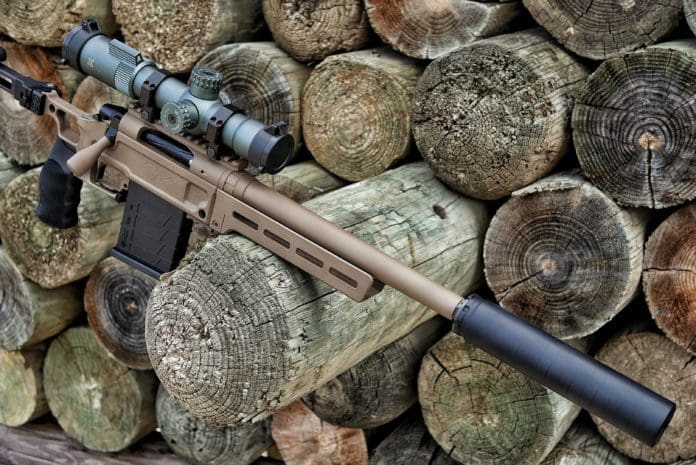
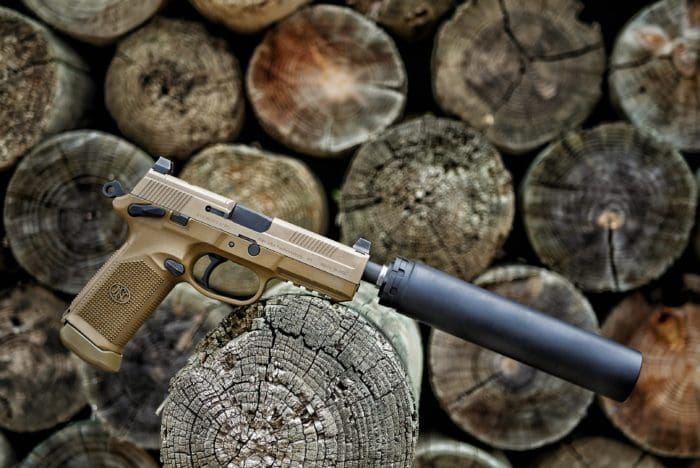






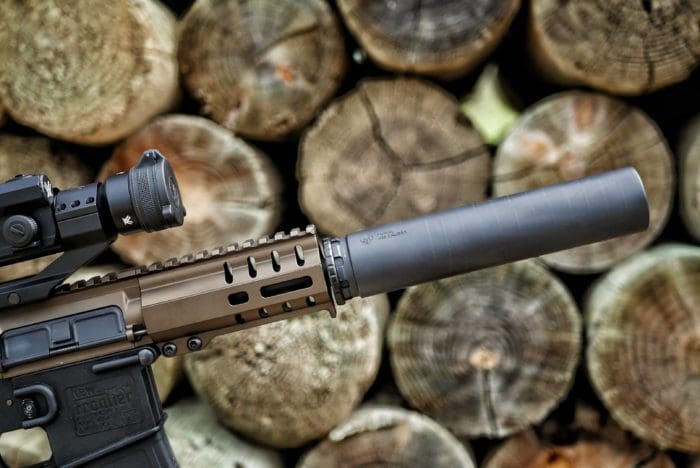
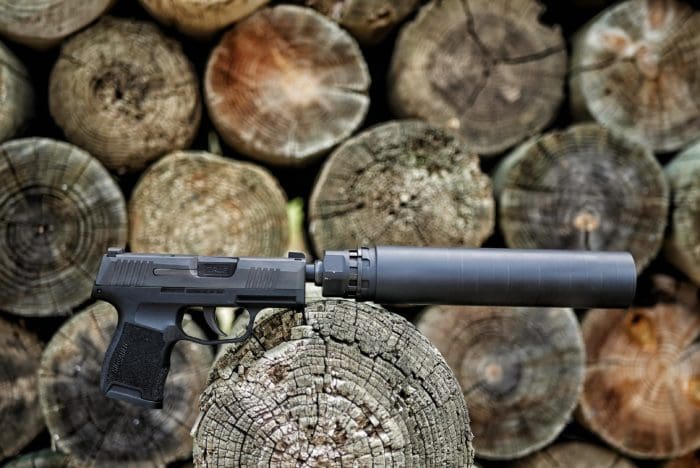




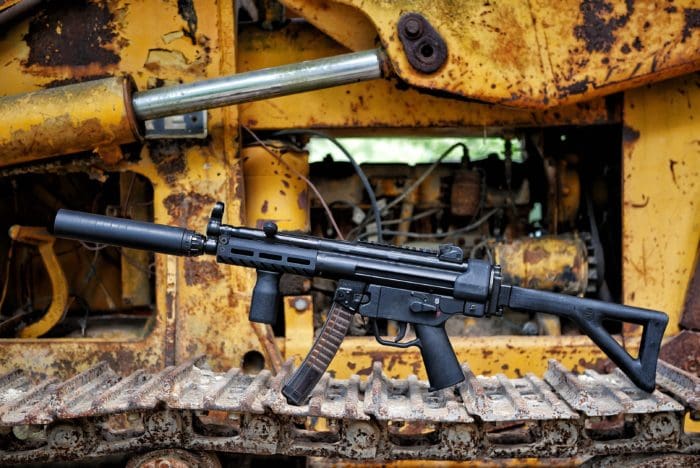



‘Why .45 caliber? Because they don’t make a .46.’
Highjacking the thread here…
Fixed long barrel can deal with the weight of the can. Got it.
How does a semi-auto pistol, with a moving barrel and springs, react to the nose heavy chunk of metal hanging out in the wind?
Always wanted to ask that.
Perhaps reading the review or watching the video would help answer that? 😆 😘 😜
Poorly. Typically a Neilsen device or booster gets attached between the muzzle of a browning tilting barrel and suppressor.
Nice review!
For the life of me, I still don’t understand why suppressor companies charge such astronomical prices for a few pieces of easily/quickly machined metal.
If the day ever comes that most suppressors–even versions like this one in this review–are around $250 or lower, I will buy several. Until then, I am a hard pass.
Now that I finished whining about suppressors prices, I have to face the fact that there is an unsavory dynamic at play from a manufacturer’s perspective: it is far-and-away more preferable to sell 10 suppressors for $100 than selling 100 suppressors for $10. While both scenarios generate the same gross revenue, there is a lot less hassle involved with selling 10 of something rather than selling 100 of something. Such is life.
That’s just not accurate. Machining all of the components from 17-4 hardened steel, laser welding them together, Cerakoting the can and nitriding the mounts, putting it all into retail packaging, and selling it to a distributor who sells it to retailers who sell it to you and making enough profit off that to sustain a company with engineers and employees and overhead and marketing and other expenses such as significant federal compliance paperwork and multiple licenses with annual fees and audits and insurance all equate to $929 being extremely reasonable. You’re DRASTICALLY underestimating what’s involved here. ….$250 could be a potentially realistic direct-to-consumer selling price if all of the regulation and record keeping and insurance requirements around making and selling suppressors didn’t exist and a cheaper material was used.
Jeremy S.,
Sincere question/s:
Do suppressor companies actually machine hardened steel? Or do they machine “generic” steel and then harden the finished result? And is “laser welding” really necessary? (I honestly have no idea on both counts.)
As for everything else that you mentioned (which I understand), how is that significantly different (in terms of the cost of doing business) from manufacturing firearms? It seems to me that if small firearm companies (such as Kel-Tec) can manufacture and sell firearms at a profit for under $300, the same should be possible for suppressors. (Correct me if I am wrong: a firearm company would have effectively identical regulatory requirements as well as the other expenses of doing business.)
It depends. 17-4PH is usually machined in an as-hardened state.
A Kel-Tec pistol has a barrel, slide, plastic frame, stamped mag, and a couple dozen simple small components. The silencer breakdown picture shows at least nine machined components of slide-like complexity.
It’s already hardened when machined. There are cheaper and easier materials to make cans from, but the good stuff costs money and machine time.
There are additional layers of regulatory requirements associated with NFA items like silencers as compared to standard non-NFA firearms (aka GCA or Gun Control Act firearms or “Title I” firearms). The other thing to keep in mind here is economies of scale. The market for a silencer is a tiny fraction the size of the market for a pistol. The manufacturer needs to recoup engineering and R&D and manufacturing equipment and rent and salaries and every other expense over a much smaller quantity of items sold, plus is paying more for raw materials and manufacturing because of the lower volume. You can build a high-volume handgun for less than half of what this suppressor would cost to make. There’s more up-front investment with injection molds and sheet metal dies, but once you’re rolling the main cost is in machining the slide whereas it’s literally pennies for a polymer frame and sheet metal FCG pieces, etc. MIM parts are pennies each. These things don’t work for suppressors because the sales volume can’t be high enough (due to $200 tax and wait time and registration) and those sorts of materials don’t hold up well. So it’s expensive material expensively machined to expensively tight tolerances and sold at pretty modest volumes.
Very good. Thank you for the information Umm and Jeremy S.
Jeremy,
Nice! Kind of a Jack-of-All-Trades suppressor.
You mentioned that when shooting 9 mm “any unburned powder and other debris” followed the bullet down the tube. How do you clean this can when it gets dirty? *
*my only suppressors, so far, are pistol, with limited centerfire rifle capability, cans that can be disassembled for cleaning.
Just fire rifle calibers through it. That’ll burn out any deposits left by pistol ammo within just a few rounds and it’ll be dry and clean inside. Dump 10 rounds of .223 through it and it would burn out anything and everything left behind by 1,000 rounds of dirty reloaded 9mm.
How about rimfire residue? Would a few rifle rounds burn/clean out rimfire residue?
Thank you for your response.
I’m still debating which .30+ cal can to add. I own several Rugged’s (which I like), unfortunately, they do not offer a rifle suppressor in the .45 – .46 range. This one is looking pretty good for all-around use.
Should drop the coin pretty soon…ain’t getting any younger.
Just thought of another question: have you ever tried a can on a black powder rifle? How’d it work?
Old Guy in Montana,
I am 99% confident that a suppressor would suppress a muzzleloader just as well as a modern centerfire rifle.
Having said that, there is a virtually guaranteed HUGE problem: black powder residue has large quantities of sulfur which promptly combines with moisture from the air to produce sulfuric acid. You would need to clean your suppressor promptly (within hours I believe) to prevent sulfuric acid build-up and damage to your suppressor.
Quieter than the hybrid or close? Decibel numbers look very close.
In my estimation it’s quieter across the board. I’d effectively ignore manufacturer numbers and wait until Silencer Shop or other reputable folks publish numbers taken on the same dB meter with the same calibration under the same conditions etc etc
Jeremy S.,
You bring up a very important point about suppressor volume levels. If someone wants to know (with confidence) how much quieter one suppressor is compared to another, in practice an uninterested party has to compare them side-by-side with the exact same sound pressure level measuring system/method.
There are too many variables from one manufacturer to another to use their published sound reduction numbers as absolutely accurate/indicative of how their suppressor performs better/worse than another.
Mater,
For reference here are generally agreed-upon qualitative relationships between human perception of sound levels and actual (measured) increase of sound levels in decibels:
1 decibel (dB) = barely noticeable change/increase in sound level
3 decibel (dB) = obvious minor increase in sound level
6 decibel (dB) = obvious significant increase in sound level
10 decibel (dB) = doubling of sound level
20 decibel (dB) = quadrupling of sound level
I do not know the numbers for the firearm suppressor of this article in comparison to other suppressors. The above reference can give you a sense of how humans would perceive the difference in performance of one suppressor compared to another. As you can see from the above reference, a suppressor would have to be on the order of 6 dB louder than another suppressor for humans to qualitatively say that it is obviously/significantly louder (although not yet twice as loud) as the other suppressor.
An “obvious minor increase” is still obvious 😉. You can hear 3 dB. I’ve done front cap swaps where testing has shown like 2.2 dB differences and it’s enough to be accurate in blind testing where somebody listens to shots and tells you which cap was on the can.
At the same time I also rank dB performance down the list of decision-making factors on suppressors behind size, weight, firing schedule restrictions, etc. If all those things are equal I’ll choose the quieter can, of course, but I’ll choose a smaller lighter can over a larger, heavier, quieter can if they’re both hearing safe on the gun I intend to put it on. In the case of the Primal and the Hybrid 46, they’re pretty damn similar in size, weight, mount system, caliber restrictions, etc etc etc so at that point I’m going to lean toward preferring the Primal since I do believe it’s quieter. And I own a Hybrid 46 by the way. But if I were making the decision today I’d get the Primal.
Agree on all points.
How about the bushwhaker?
I borrowed the Bushwhacker once but the first thing I did was install it on a .458 SOCOM with a .30 cal muzzle brake and proceed to immediately grenade the brake into the suppressor with a couple shots. Explosive frag injection right into the can 😆. First, the can was totally fine. Absolutely shrugged it off with only a couple little dents to the bore of the blast baffle. Second, in my defense I was given the SOCOM, the mount, and the can to use together so I didn’t inspect the mount, I just shot what I was given haha
I’m really looking forward to getting to a free state and buying a can or two. I must say that I really think he just wanted to show us his sexy legs in the video.
You’re welcome. Please subscribe to my Only Fans.
Njfhsjdwkdjwfh jiwkdwidwhidjwi jiwkdowfiehgejikdoswfiw https://gehddijiwfugwdjaidheufeduhwdwhduhdwudw.com/fjhdjwksdehfjhejdsdefhe
Comments are closed.